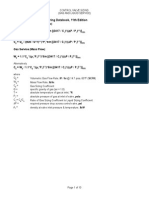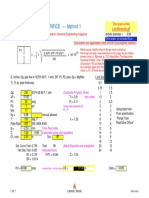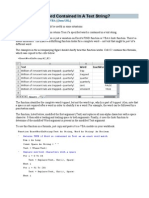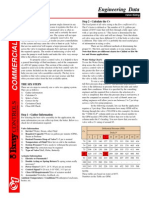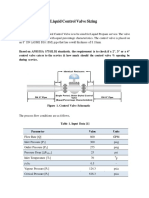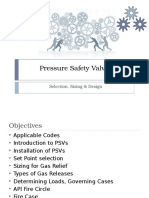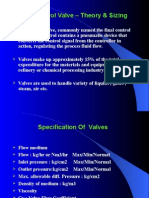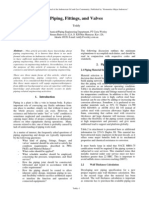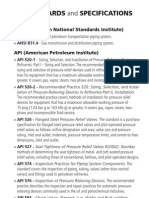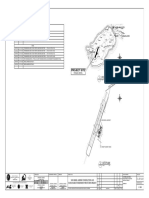Control Valve Sizing
Control Valve Sizing
Uploaded by
jmclaug502Copyright:
Available Formats
Control Valve Sizing
Control Valve Sizing
Uploaded by
jmclaug502Copyright
Available Formats
Share this document
Did you find this document useful?
Is this content inappropriate?
Copyright:
Available Formats
Control Valve Sizing
Control Valve Sizing
Uploaded by
jmclaug502Copyright:
Available Formats
Control Valve Sizing Step 1: Define the System Variables System Variables System fluid Specific gravity of fluid
Fluid temperature Vapor pressure, Pv Flowrate Pressure @ Valve Inlet, P1 Pressure @ Valve Outlet, P2 Pressure Drop, P Valve Recovery Factor, Km Cavatation Index Factor, Kc Critical Pressure Ratio, rc 0.80 0.95 0.92 F psig gpm psig psig psi Units Location/Equation* P&ID Fluids Text Heat Balance / Vendor P&ID Fluids Text Heat Balance / Vendor P&ID See Below** See Below*** P = P1 - P2 Constant Constant Constant
* Indicates where or how the particular system variable can be found or calculated. ** P1 = Pump Discharge Head - Friction Losses - Flow Element Loss - Static Head *** P2 = Drum Pressure + Friction Losses + Flow Element Loss + Static Head
Step 2:
Define the Inlet and Outlet Pipe/Line Conditions Line Condtions Pipe size Pipe wall** Connection type*** Pressure class lb Inlet Units in Sch / in lb Outlet Units in Location* Isometric
Sch / in Isometric Isometric Isometric
* Indicates where the particular line condition can be found. ** Refers to the pipe schedule or minimum wall thickness. *** Refers to how the valve will be connected to the pipe. Ex. Butt weld, Flanged, etc. Step 3: Define the Allowable Pressure Drop for the Valve Pallow = Km(P1 - rc*Pv) Allowable DeltaP, Pallow Step 4: Determine if Cavitation Control is Needed If P > Pallow Cavitation Control is needed. If P < Pallow Cavitation Control is not needed. Step 5: Predict the Pressure Drop at which the Valve will begin Cavitation Pc = Kc(P1 - Pv) Pc Step 6: Calculate the Valve Flow Coefficient, Cv psi psi
G P
where, Cv is the valve flow coefficient Q is the flow rate (maximum, normal, minimum), gpm G is the specific gravity of fluid P is the pressure drop (psi) across the valve for corresponding flowrate Cv
Step 7:
Repeat Steps 1 through 6 for all other operating conditions. (ie maximum, minimum and normal conditions)
Step 8:
Select the Valve Type Decide which type valve is best for your application. The valve types are listed on following pages.
Step 9:
Select the Valve Size Use the calculated Cv's and manufacturer supplied chart to choose the proper valve size. Below is an example of a manufacturer supplied chart.
Useful Tips: Manufacturer supplied charts can be found in a valve vendor catalog. Try not to use a valve that is less than half the pipe size. A valve is much easier to control in the 30-70% travel range. Step 10: Contact the Valve Vendor(s) At this point contact the valve vendor(s) and present the above information. The vendor may be useful in the final selection of the valve that is best for your application.
Valve Types Gate Valve Type Service: Fluids: On-Off Steam Feedwater Condensate Isolation Non-throttling Infrequent operation Low cost High capacity Tight shutoff Low pressure drop Poor flow control Prone to cavitate at low pressure drops
Systems: Recommended Uses:
Advantages:
Disadvantages:
Ball Valve Type Service: Fluids: On-Off Steam Condensate Natural Gas Balance of Plant Fully open/closed or limited throttling High temperature fluids (steam drains) Back pressure control
Systems: Recommended Uses:
Advantages:
High capacity Low leakage Tight sealing with low torque Poor throttling characteristics Prone to cavitation
Disadvantages:
Butterfly Valve Type Service: On-Off Flow Control Condensate Circulating Water Raw Water Balance of Plant Fully open/closed or throttling Frequent operation Low cost High capacity Good flow control Low pressure drop High torque required for control Prone to cavitation at lower flows Flow obstruction due to center post
Fluids:
Systems: Recommended Uses:
Advantages:
Disadvantages:
Globe Valve Type Service: Pressure control Flow control Temperature control Steam Feedwater Condensate Natural Gas Critical Service Bypass Balance of Plant Natural Gas Throttling Frequent operation Efficient throttling Accurate flow control Available in multiple cages* High pressure drop More expensive than other valves
Fluids:
Systems:
Recommended Uses:
Advantages:
Disadvantages:
* Characterized Cages for Globe-Style Valve Bodies Equal Percentage: Equal increments of valve travel produce an equal percentage in flow change. Used in processes where large changes in pressure drop are expected. Used in processes where a small percentage of the total pressure drop is permitted by the valve. Used in temperature and pressure control loops.
Linear:
Valve travel is directly proportional to the flow change. Used in liquid level or flow loops. Used in systems where the pressure drop across the valve is expected to remain fairly constant. Used in steady state systems.
Quick Opening:
Large increase in flow with a small change in valve travel. Used for frequent on-off service. Used for processes where "instantly" large flow is needed. Used in safety systems or cooling water systems.
Other Valves Check Valve Designed to restrict the flow to one direction. If the flow reverses direction, the check valve will close. Designed to regulate the operating pressure of incompressible flow. Used to release excess pressure in gases or compressible fluids. Designed for on-off service and some throttling services. Controls flow by means of a cylindrical or tapered plug with a hole in the center that lines up with the flow path of the valve to permit flow. A quarter turn in either direction blocks the flow path. Designed particularly for applications of slurries or liquids with large amounts of suspended solids. It seals by means of one or more flexible elements, such as a rubber tube, that can be pinched to shut off flow. Designed to close by means of a flexible diaphragm attached to a compressor. When the compressor is lowered by the valve stem onto a weir, the diaphragm seals and cuts off flow. Used to handle corrosive, erosive and dirty services.
Relief Valve
Plug Valve
Pinch Valve
Diaphragm Valve
ocation*
You might also like
- GPSA Control Valve SizingDocument10 pagesGPSA Control Valve Sizingbakhtyar21100% (1)
- Thermal Relief Therm - VTDocument6 pagesThermal Relief Therm - VTRafael ReyesNo ratings yet
- Restrictive Orifice - Method 1: Rough Method Provided Originally in An Article in Chemical Engineering MagazineDocument1 pageRestrictive Orifice - Method 1: Rough Method Provided Originally in An Article in Chemical Engineering MagazinealvinchuanNo ratings yet
- Siemens Valve SizingDocument32 pagesSiemens Valve SizingSteven Wei100% (2)
- Control Valve Sizing and Selection: STEP #1: Define The SystemDocument5 pagesControl Valve Sizing and Selection: STEP #1: Define The Systemprassna_kamat15730% (1)
- Excel Cheat SheetDocument74 pagesExcel Cheat Sheetjmclaug502No ratings yet
- Forhtml - Af Imt Form 1222 Boiler or Pressure Vessel Inspection Report PDFDocument2 pagesForhtml - Af Imt Form 1222 Boiler or Pressure Vessel Inspection Report PDFReama QumsanNo ratings yet
- Armstrong FTVDocument6 pagesArmstrong FTVMaxi452No ratings yet
- K Value of FittingsDocument4 pagesK Value of FittingsJoydip Misra100% (8)
- Cepde - Valve Sizing (U16ch036, U16ch037, U16ch083)Document15 pagesCepde - Valve Sizing (U16ch036, U16ch037, U16ch083)VRUSHABHNo ratings yet
- Control Valve Sizing-Engineering DataDocument21 pagesControl Valve Sizing-Engineering Datapalindapc100% (1)
- Process Engineer - PSV SizingDocument3 pagesProcess Engineer - PSV SizingLaorencia0% (1)
- Control Valve Failure Relief Rate - Gas ServiceDocument3 pagesControl Valve Failure Relief Rate - Gas ServiceSaeid Rahimi Mofrad100% (2)
- Liquid Orifice SizingDocument8 pagesLiquid Orifice SizingrmaganNo ratings yet
- Control Valve SizingDocument21 pagesControl Valve Sizingtiwarishailendra2198100% (1)
- Orifice Sizing PrinciplesDocument12 pagesOrifice Sizing Principlesjlcheefei9258100% (2)
- Relief Load CalculationDocument8 pagesRelief Load CalculationMuthuKumar ArunachalamNo ratings yet
- Blowdown Orifice Sizing CalculationDocument1 pageBlowdown Orifice Sizing Calculationlutfi awnNo ratings yet
- Control Valve Sizing: Unit L m3/d 1800 1.03 Bar 8.2 Bar 7.2 Bar 1 °C 120 Bar in 3 in 4Document4 pagesControl Valve Sizing: Unit L m3/d 1800 1.03 Bar 8.2 Bar 7.2 Bar 1 °C 120 Bar in 3 in 4ghandri1986No ratings yet
- Ogpe OGPE Oil Fields: Calculation SheetDocument4 pagesOgpe OGPE Oil Fields: Calculation SheetFaber TrujilloNo ratings yet
- Liquid Control Valve SizingDocument9 pagesLiquid Control Valve SizingDesiree MolinaNo ratings yet
- Spreadsheet - Gas Blanketed Tanks - Outbreathing Process Calculations & Control Valve Sizing - Rev2Document33 pagesSpreadsheet - Gas Blanketed Tanks - Outbreathing Process Calculations & Control Valve Sizing - Rev2MaheshNo ratings yet
- PSV Thermal SizingDocument16 pagesPSV Thermal Sizingahmad santoso0% (1)
- Calculation For Restriction OrificeDocument4 pagesCalculation For Restriction OrificeAshish PawarNo ratings yet
- Control Valve Pressure Drop and Sizing: ContentDocument19 pagesControl Valve Pressure Drop and Sizing: ContentSingarao KattaNo ratings yet
- Column Diameter Hetp CheckDocument6 pagesColumn Diameter Hetp CheckOmar EzzatNo ratings yet
- Validation Report On The 2 Phase Line Sizing 3 PDFDocument18 pagesValidation Report On The 2 Phase Line Sizing 3 PDFJoseph MedinaNo ratings yet
- Two-Phase Flow - Condensate Drain Lines Design GuideDocument2 pagesTwo-Phase Flow - Condensate Drain Lines Design Guidec_nghiaNo ratings yet
- NPSH Calculator For Process EngineerDocument14 pagesNPSH Calculator For Process Engineerlutfi awnNo ratings yet
- Korf Utility: File Name Names List Sorted Names File DetailsDocument15 pagesKorf Utility: File Name Names List Sorted Names File DetailsFarhan AhmedNo ratings yet
- Restriction Orifice SizingDocument5 pagesRestriction Orifice Sizingjoe50% (2)
- Pressure Safety Valves: Selection, Sizing & DesignDocument19 pagesPressure Safety Valves: Selection, Sizing & DesignAbdulAbdul100% (1)
- A Guide To Sizing Orifice Plate Flow MetersDocument4 pagesA Guide To Sizing Orifice Plate Flow Meterscldanghel4648100% (2)
- Calculate The Relieving Temperature Latent Heat of Vaporization For Fire Case PSV Sizing by Shell DEP Method PDFDocument3 pagesCalculate The Relieving Temperature Latent Heat of Vaporization For Fire Case PSV Sizing by Shell DEP Method PDFDjamel Ait MohamedNo ratings yet
- Sizing Calculation SHTDocument3 pagesSizing Calculation SHT903352100% (1)
- Relief Valve Sizing - FireDocument2 pagesRelief Valve Sizing - Firevlcmstne04100% (1)
- Gas Control Valve Sizing: (Masoneilan)Document1 pageGas Control Valve Sizing: (Masoneilan)Tun Naing WinNo ratings yet
- Sizing Calculation Spreadsheet PSVDocument1 pageSizing Calculation Spreadsheet PSVkenoly123No ratings yet
- 2K MethodDocument5 pages2K MethodLind D. QuiNo ratings yet
- Storage Tank Venting - API 2000, 7th EditionDocument9 pagesStorage Tank Venting - API 2000, 7th EditionPhucNo ratings yet
- Installed Flow CharacteristicsDocument4 pagesInstalled Flow CharacteristicscymyNo ratings yet
- Control Valve Sizing - Liquid Rev 2aDocument2 pagesControl Valve Sizing - Liquid Rev 2aQC osbl100% (1)
- Rosemount 1495 Orifice Plate, 1496 Flange Union, 1497 Meter SectionDocument24 pagesRosemount 1495 Orifice Plate, 1496 Flange Union, 1497 Meter SectionJames ThomasNo ratings yet
- Relief Load Calculation For Fire Case - As Per API 521Document1 pageRelief Load Calculation For Fire Case - As Per API 521ktejankar100% (2)
- Presure Regulator Calculate PDFDocument5 pagesPresure Regulator Calculate PDFGorast KolevNo ratings yet
- Two - Phase Line Sizing GelamDocument5 pagesTwo - Phase Line Sizing GelamElias EliasNo ratings yet
- PSV SizingDocument8 pagesPSV SizingMinh DoNo ratings yet
- Guidelines For Sizing of Restriction Orifice For Single-Phase Fluids With PDFDocument8 pagesGuidelines For Sizing of Restriction Orifice For Single-Phase Fluids With PDFEPTCO LHDNo ratings yet
- Control Valve Sizing Theory, Cavitation, FlashingDocument45 pagesControl Valve Sizing Theory, Cavitation, FlashingVitória Marcenaria100% (3)
- Pemex BA-1071 F. 27898 Bombas Pozo Profundo Tapachula, ChiapasDocument3 pagesPemex BA-1071 F. 27898 Bombas Pozo Profundo Tapachula, ChiapasMarti H JNo ratings yet
- Restriction Orifice Calculation SheetDocument2 pagesRestriction Orifice Calculation Sheetparykoochak50% (2)
- Pump Head CalculationDocument15 pagesPump Head CalculationYashapuja100% (2)
- Control Valve PresentDocument120 pagesControl Valve PresentShoeb Ali Khan100% (2)
- 3B - Inst - Control ValveDocument31 pages3B - Inst - Control ValveMystic AamirNo ratings yet
- Control Valve - Theory & SizingDocument29 pagesControl Valve - Theory & SizingSandeep KulathapallilNo ratings yet
- Valve Sizing: Cepde AssignmentDocument15 pagesValve Sizing: Cepde AssignmentVRUSHABHNo ratings yet
- Valve Sizing: Cepde AssignmentDocument15 pagesValve Sizing: Cepde AssignmentVRUSHABHNo ratings yet
- Control Valve Sizing PDFDocument5 pagesControl Valve Sizing PDFjainrakeshj4987100% (1)
- Lab Report: Instrumentation and ControlDocument7 pagesLab Report: Instrumentation and ControlmjunaidNo ratings yet
- Control Valve CharacteristicsDocument9 pagesControl Valve CharacteristicsSiddhartha Sharma100% (1)
- Pressure Independent Control ValveDocument12 pagesPressure Independent Control Valvekya_leyNo ratings yet
- Engineering Technical Bulletins: Selecting Valves and Piping CoilsDocument4 pagesEngineering Technical Bulletins: Selecting Valves and Piping Coilsforevertay2000No ratings yet
- FlowCon PICV Write OutDocument17 pagesFlowCon PICV Write OutmajortayNo ratings yet
- Calculating Pump HeadDocument8 pagesCalculating Pump HeadPascal SayahNo ratings yet
- Heat ExchangerDocument155 pagesHeat ExchangerSajilal JosephNo ratings yet
- Combined Cycle (FGD)Document20 pagesCombined Cycle (FGD)jmclaug502No ratings yet
- Heat ExchangerDocument155 pagesHeat ExchangerSajilal JosephNo ratings yet
- Paper ProcessDocument1 pagePaper ProcessWesley Apla-on MiguelNo ratings yet
- Piping DesignDocument9 pagesPiping Designjmclaug502No ratings yet
- Calculation Cover Sheet: Mechanical Generic Project Name Pipe Wall Thickness Calculations System Name Wall ThicknessDocument2 pagesCalculation Cover Sheet: Mechanical Generic Project Name Pipe Wall Thickness Calculations System Name Wall Thicknessjmclaug502No ratings yet
- MS Access 2007Document13 pagesMS Access 2007jmclaug502No ratings yet
- Engineering PipingDocument18 pagesEngineering Pipingjmclaug502100% (4)
- Mercer Valve 9100 Relief Valve Threaded AEDocument16 pagesMercer Valve 9100 Relief Valve Threaded AEdoens JKTNo ratings yet
- Reynolds Experiment: Lab 2 Division of Fluid Mechanics, LTHDocument2 pagesReynolds Experiment: Lab 2 Division of Fluid Mechanics, LTHkonekticutNo ratings yet
- Standards and Specifications: ANSI (American National Standards Institute)Document5 pagesStandards and Specifications: ANSI (American National Standards Institute)norhazarudinNo ratings yet
- ListDocument12 pagesListashishtaneja30No ratings yet
- Turbo 142 2 021004Document14 pagesTurbo 142 2 021004boroumandNo ratings yet
- Orifice MeterDocument7 pagesOrifice MeterCeazar Justine Fulugan100% (2)
- One Touch Fittings PDFDocument11 pagesOne Touch Fittings PDFMohan ShanmugamNo ratings yet
- Ms Trading Pipefittingcatalogue Dec2016 ElectronicDocument44 pagesMs Trading Pipefittingcatalogue Dec2016 ElectronicANV100% (1)
- 0096Document1 page0096buddhansamratNo ratings yet
- Pipa ScheduleDocument7 pagesPipa ScheduleHongKyz Jovianz X-BoyzNo ratings yet
- Fluid Machinery Lecture PlanDocument2 pagesFluid Machinery Lecture Planविन्तु अधिकारीNo ratings yet
- Weld and Split Sleeve Fittings & AccessoriesDocument12 pagesWeld and Split Sleeve Fittings & AccessoriesbederinadmlNo ratings yet
- Circuit Setter Sizing - Rev.8/14: He Following Chart Is Recommended For Sizing ITT Bell and Gossett Circuit SettersDocument1 pageCircuit Setter Sizing - Rev.8/14: He Following Chart Is Recommended For Sizing ITT Bell and Gossett Circuit SettersCarlos PerezNo ratings yet
- BHDT Fertilizer Engl Neu OnlineDocument8 pagesBHDT Fertilizer Engl Neu OnlinelalitbadheNo ratings yet
- The Pneumatics Installation GuideDocument186 pagesThe Pneumatics Installation GuideHAMIT100% (1)
- DB 650 GBDocument6 pagesDB 650 GBDenial BasanovicNo ratings yet
- AC10 AC60: Air Filter + Regulator + LubricatorDocument5 pagesAC10 AC60: Air Filter + Regulator + LubricatorElsonMilanNo ratings yet
- Model 4WI 100 - 800 HP Boilers: Oil-Fired BurnersDocument4 pagesModel 4WI 100 - 800 HP Boilers: Oil-Fired BurnerssebaversaNo ratings yet
- Ranto Manullang KDTP - 2008Document33 pagesRanto Manullang KDTP - 2008Rahadian Dwi PutraNo ratings yet
- No 1. Certificate Will Be Provided by Vendor: - According To VDRLDocument32 pagesNo 1. Certificate Will Be Provided by Vendor: - According To VDRLBella Novia BerlianaNo ratings yet
- P2 Training For Hyva - PPT - Modo de CompatibilidadDocument55 pagesP2 Training For Hyva - PPT - Modo de CompatibilidadJose OrjuelaNo ratings yet
- Values Highlighted in GREEN Are Calculated Values: Suction Fittings & ValvesDocument44 pagesValues Highlighted in GREEN Are Calculated Values: Suction Fittings & ValvesgabriejyjNo ratings yet
- Flow Around Submerged Bodies-Drag GATEDocument7 pagesFlow Around Submerged Bodies-Drag GATEhcsharma1967No ratings yet
- New Bohol Airport ConstructionDocument10 pagesNew Bohol Airport ConstructionFe PastorNo ratings yet
- Pump Performance Datasheet: Operating Conditions LiquidDocument2 pagesPump Performance Datasheet: Operating Conditions LiquidAntonio ChavezNo ratings yet
- Presure Limiting Load Sensing Compensator Pvb5 Thru Pvb29Document2 pagesPresure Limiting Load Sensing Compensator Pvb5 Thru Pvb29loloeasNo ratings yet
- Answers To ProblemsDocument8 pagesAnswers To ProblemsSeba BojaNo ratings yet
